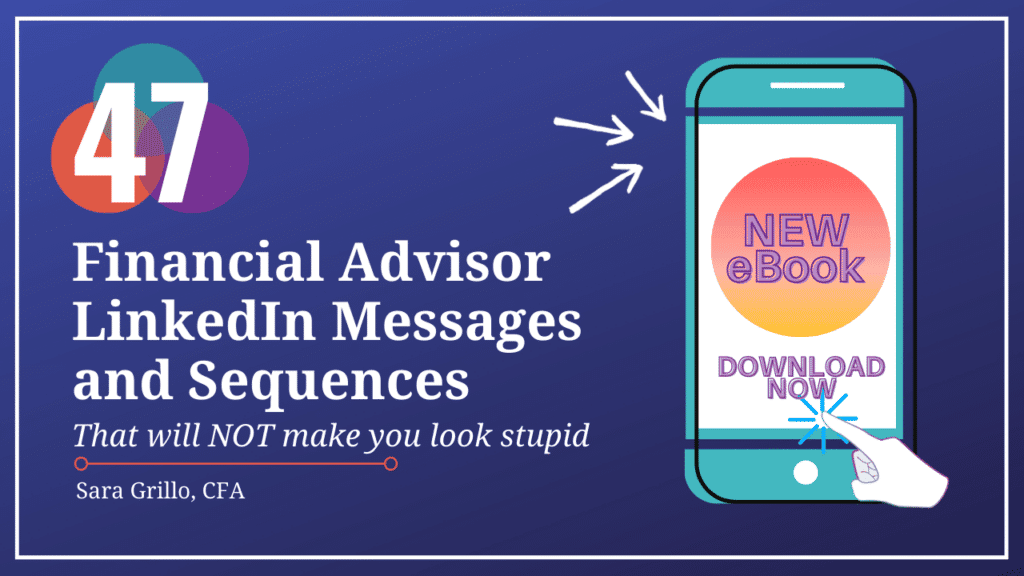In this blog, you’ll hear about five tips for getting a financial advisor blog through compliance. Difficult, but not impossible.
For those of you who are new to my blog/podcast, my name is Sara. I am a CFA® charterholder and I used to be a financial advisor. I have a weekly newsletter in which I talk about financial advisor lead generation topics which is best described as “fun and irreverent.” So please subscribe!

Let’s get on with the blog!
Here are 5 financial advisor compliance tips
Whether they are a financial advisor at an RIA firm or a broker-dealer, the conversation always seems to go the same way. Immediately after a financial advisor agrees that writing a blog post with me would be a great way to improve branding, the next words out of their mouth are always, “But what about getting a blog through my compliance department? Such a pain in the neck and it takes forever.”
Have you ever said these words, or something to that effect? As someone who has both been a financial advisor in the past — and now writes financial advisor blogs for a living– I can offer 5 painless tips for getting your financial advisor blog (and investor decks, social media postings, or any other content) through compliance.
#1 Understand the Mindset of the Compliance Professional
The bell rings…ding, ding, ding…
In one corner, in the gold trunks weighing in at 180 pounds, three time Golden Glove Champion, your firm’s Chief Compliance Officer!
In the second corner, in the red and black trunks weighing in at 150 pounds, the challenger, Financial Advisor Joe!
What a battle. Sound like your situation? In my talks with financial advisors, I’ve heard the tone get downright adversarial when it comes to their experiences getting content through compliance. It doesn’t have to, and should not be, this way. Here’s why: compliance has ultimate authority over what goes through and what doesn’t.
They make the decision.
Fight them, and they will win.
Understand their mindset and strive to cooperate as much as possible, and you’ll find that over time they’ll loosen up that tight upper lip and make things easier for you.
What is running through the compliance officer’s mind when he/she sees your blog in the queue
So let’s start by looking at what the Chief Compliance Officer at your firm thinks about as he or she is commuting to work everyday. Unlike financial advisors, they aren’t paid for productivity. They’re paid to minimize risk. Their worst nightmare is letting something slide that gets picked up by the regulators or results in a compliance breach, because that can only happen once or twice before they’re out on the street looking for a new job.
There’s no relationship and no trust most of the time. The compliance officer has no incentive to cut you any slack because you’re just another number. You are not their friend, you are the enemy because you acting upon even the slightest oversight can get them canned, the slightest slip up, the most minor miscommunication. There are only two exceptions. I’ve found in my work with broker-dealer teams, the advisors who either are the top producers or have already established trust with compliance are the ones whose content gets placed at the top of the pecking order. But what do you do if you’re not one of these select few?
How to minimize the compliance back and forth “dance”
The answer is that you have to “sell” yourself to them. Just as you would to a prospect, build trust gradually. You wouldn’t expect to close a sale on the first phone call, would you?
No.
You take the time to do things like meet with the prospect, ask them questions to seek to understand their challenges and goals better, and then to set forth a plan of action that they will agree to. You see over time that this warms up even the toughest of skeptics.
Getting compliance buy in
That’s really critical: get their buy-in. How do you do that?
- First of all, give compliance a long lead time when you first start to work together. Don’t make your first submission be about an event happening a week from now. Give them a ridiculous amount of lead time, as much as you can.
- Give them a heads up. Either meet with them in person or have a phone conversation about what you want to write about, and be clear. Ask for their advice about what would make it easy to get it approved. Maybe even submit an outline of the posting before you write the content so that you don’t waste time writing on something they have to ding.
- Make the content appealing and entertaining to read. Keep in mind they have to read a million dry, boring financial advisor blogs all day long. Using humor and other techniques that I’ll discuss later in this article might just make them enjoy reading what you write and let’s be honest that makes them feel more inclined to support what you’re trying to do.
- Lastly, give them a break and steer clear of the problem areas. Just like that one teacher in school that everyone said was such a hard grader and would return your essay with red pen scratches everywhere, understand what it is likely to get their goat. I’ll comment more on this topic later in my article, but the list includes anything related to performance, track record, and advertising or soliciting your firm.
How do you make an article meaningful without discussing these topics, you may ask. Behold the answers in the next section!
#2 Avoid the Landmines
Your compliance officer is a person, too – you got it, and that’s great – but you’re still sitting there saying, “I know they have a job to do, but so do I, and how do I get new clients for my business if I can’t even utter a single word on social media!”
Argh!
I gotcha. By the way, here are some ideas about how to do that from my YouTube channel.
Financial advisors complain that they can’t get anything meaningful through compliance. In reality, though, most advisors feel that in order to show value they need to predict the market, pitch products, boost about past trades, or their firm. In reality (and especially if you are marketing to certain generations such as Millennials) it’s all been said before and if you really want to rise above the noise you have got to come up with something different anyways.
People choose you based upon service, not product, most of the time. So serve them like clients! Give them the gift of knowledge with an intriguing, spot on, highly relevant piece. The best financial advisor blogs answer questions that people have. The way Google and the social media engines work is through relevance.
For example, if you were to do some online searches and research the questions that people tend to have about mortgages, it’s not about the intricacies of the paydown schedule. People use the Internet for “social learning”, reading threaded conversations where they can learn through the experiences of other people.
If I were a financial advisor who wanted to find the buzz uttered by people who were first time home buyers, I’d visit the Quora mortgage page (“Mortgages”, n.d). The biggest question people tend to have is about the mistakes first time home buyers make. Other topics involve the actual process of working with a loan officer, PMI, ARMs, and how to work with lenders. These are examples of great financial advisor blog topics. Establishing yourself as an expert by answering questions relevant to first time home buyers will get your content liked, shared, and indexed better by Google because you are, in a sense, providing a service online to people through your content.
What prevents many people from answering questions this way is the fear of doing work for free. Nobody can argue that getting paid is the end goal for everyone in business. Yet there is some grinding that you have to do before you can earn the privilege of getting paid 100% of the time for your wisdom. Most of the really successful people will say that, online or not, they only get paid for 25% of the work they do. Show enough value, and eventually the leads will come. Talk to what people want to hear about, and eventually the paying clients will hear you.
If you want to build your cybercredibility, traffic is what matters to Google. You may get 1k views and only one lead, but in a sense the rest of the 999 people have paid you with their view. I caution my clients not to underestimate the value of being followed online. A subscriber may not have an immediate need but over time chances are that they or someone connected to them will. Herein lies the importance of the financial advisor sales funnel. Touch them once or twice a month with value rich, insightful content through newsletters, social media, and even direct visits or calls, and you’ll see them convert over time.
#3 Find a Financial Copywriter
I find that many financial advisor blogs run into problems with compliance because of how they phrase things. This takes a certain degree of writing skill that may or may not be a priority for the advisor to have. You don’t have to reinvent the wheel; hire a good financial copywriter, one who is familiar with FINRA and other regulations governing the copy, can save you the headache of going back and forth with compliance ad nauseam.
Here are some examples of phrasing that can improve compliance success. In each case, I’ve presented the novice phrasing as well as the way a professional financial copywriter would phrase it.
Distressed debt is a great addition to any large pension portfolio who wants to outperform.
Distressed debt has become a popular investment choice for many of the top global pension funds such as CalPERS.
What makes this good copy? The balanced view that it provides. While a novice writer would express a strong opinion that may be construed financial advice (which is the compliance officer’s pet peeve), a professional writer will couch this opinion in fact.
Technology is bound for a reversal and is one of the best places for your money in 2018.
When arranging a target asset allocation, investors may find it useful to consider a range of sectors where economic growth may likely be on the rebound. While the future can never be predicted, a likely source of economic growth in years to come will be the sizzling technology sector which has most likely hit rock bottom. Experts see this sector as due for a turnaround in 2018. Do you agree?
The lesson here is to ask, not advise. The language in the second statement is conditional rather than absolute, i.e. “may find”, “can never be predicted”, “most likely.” These words are soothing to the compliance officer’s ears!
Hedging strategies shield investors from dips in the market.
Hedging strategies are a form of risk management put in place when an investor wishes to obtain a way to protect the portfolio from dips in the market.
What makes the second example of copy easier on the compliance officer is the higher truthfulness of the second statement. While statement #1 is true is some cases, it’s not always what ends up happening. Compliance officers love it when you explain the strategy and the goal rather than making blanket statements about outcomes that may or may not apply in all situations.
Hiring the right copywriters is key to getting a financial advisor blog through compliance. Before you hire one, make sure that you get straight what kind of financial advisor blog content you’d like produced. Some copywriters just recycle canned content that has already been used elsewhere for other clients. You don’t want to be left holding the bag when it comes to plagiarism. Be sure to search on a few phrases by inputting them directly in Google just to make sure that what you get hasn’t been published elsewhere. Or, you can consult with one of the free plagiarism check services available through sites such as Grammarly.
#4 Include Graphics
As someone who produces digital copy for a living, it’s clear to me that the best received content is visual. I don’t mean graphs and charts, I mean imagery that conveys the message you’re trying to make. For example, if you’re talking about how a particular rebalancing technique works well for pension funds, include a picture of pension fund employees sitting around a conference table looking happy instead of a boring old graph of historical performance.
You know the saying that a picture is worth a thousand words. Spice up your piece with stock photos or designed images that convey your point creatively. Compliance won’t have anything to say about it and your audience will like the article better.
By the way, for those of you who are looking to penetrate a local market, including keyword-rich labelled graphics is a great way to juice up your SEO. So are Infographics. Google loves these!
Where can you find these images? Check out stock photo websites such as Pexels or Shutterstock. For custom designed images, you can hire resources inexpensively through freelancer sites such as Fiverr.
#5 Distribute Like Crazy
Getting your content in front of a targeted audience is a great way to get views on the article without having to go to town on the content. Don’t get me wrong; I’m not saying that there is ever a good reason for weak content. I’m saying that a well targeted message put in front of the right group will go far just because you’re speaking to the right people.
If you’re a compliance officer, which article do you review first (and possibly be a tiny bit more lenient towards). One, a financial advisor blog that went on a rep’s blog and got 50 views, no comments, no leads, and net-net did not earn money for the firm? Or scenario #2, let’s say that article got picked up by CNBC and featured as syndicated content, gaining attention for both the rep and the firm, got backlinked to by several websites, earned over 1,000 views and led to several new prospects getting in touch with the rep? These #2 articles make the compliance officer look great and would motivate them to put your order first the next time around.
Bonus tip for financial advisors: don’t forget LinkedIn Messenger!
Use LinkedIn instant messaging to talk to your contacts. This is not something to be taken lightly. Many people will engage over instant messaging just because they are online whereas if you sent an email they would never respond. As long as you are messaging one person at a time, this doesn’t count as “advertising.”
Many compliance departments will track this activity but do not require pre-approval. This is a great way to communicate freely over social media and get attention from prospects that might be in your network. Scour your contact list and see who might be a potential prospect or center of influence and then ping them.
Sara’s Upshot on financial advisor compliance
What’d ya think? Was this helpful?
If yes…
Learn what to say to prospects on social media messenger apps without sounding like a washing machine salesperson. This e-book contains 47 financial advisor LinkedIn messages, sequences, and scripts, and they are all two sentences or less.

You could also consider my financial advisor social media membership which teaches financial advisors how to get new clients and leads from LinkedIn.

Thanks for reading. I hope you’ll at least join my weekly newsletter about financial advisor lead generation.
See you in the next one!
-Sara G
Sources: Mortgages. (n.d.) Quora. Retrieved from https://www.quora.com/topic/Mortgages. Accessed July 25, 2017.





